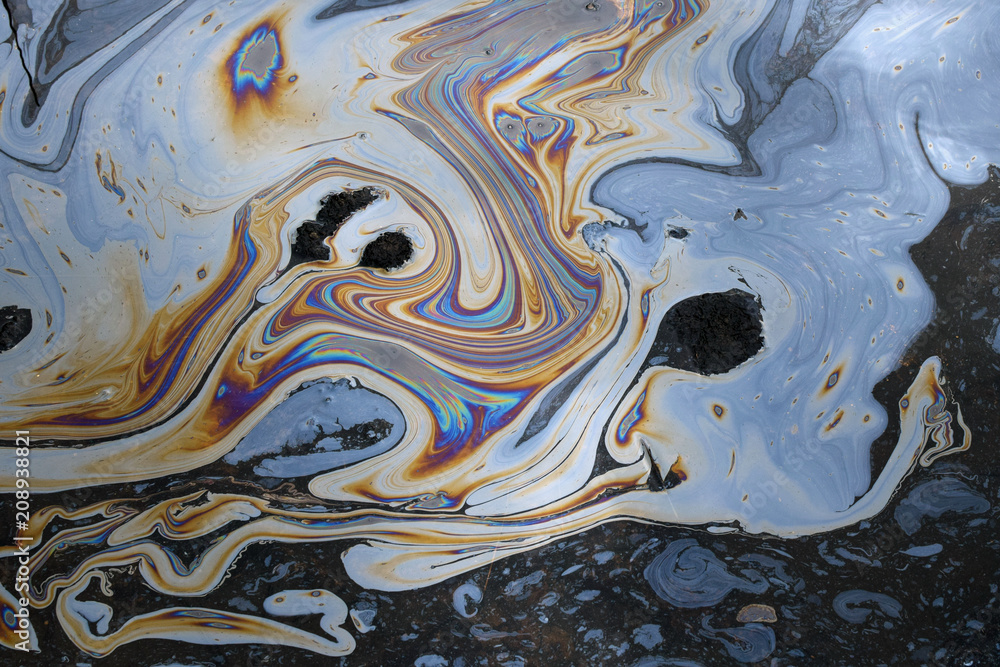
by Dana Stephens | May 12, 2025
Spring is a time of change. Spring brings changes in our waters as well. Some of these changes are visible on top of the water and cause concern among water users and viewers. Let’s dispel some of these concerns associated with the spring season.
Sometimes, water users and viewers notice what appears to be oil floating on top of the water. Could this be oil? Potentially. Could this not be oil? Most likely. Plants perish, and decomposition occurs, typically during the spring and fall seasons of the year. Much of the decomposition that happens in spring is associated with the initial growth and development of plants. Bacteria living in the soils within and around the water break down the perished plants. These bacteria are decomposing the old plant material. The waste product produced from the bacteria’s decomposition of the old plant material is an oily substance. The oily sheen on the water is a waste product of bacteria. Frequently, the oil accumulates in portions of water where there is little to no water movement. As the decomposition process completes, the oily sheen should lessen over the next few days to weeks. This bacteria-produced oil from decomposition is a natural process.
Petroleum-based oil seen on water is not a natural process. Petroleum-based oil could enter water from various sources, such as but not limited to transportation spills, stormwater runoff, and improper disposal of products containing oil. Like the oily substances produced by bacteria during decomposition, petroleum-based oils will float on top of the water and accumulate where there is little to no water movement.
Here are some tips to identify the difference between oils in water:
|
Bacteria-produced Oil |
Petroleum-based Oil |
| Appearance |
Oily sheen on top of water with little to no difference in color throughout |
Oily sheen on top of water with differences in color throughout (may even appear like a rainbow) |
| Touch
(use a stick) |
When disturbed, the sheen breaks away easily with irregular patterns and does not reform. The oil will not adhere to the stick. |
When disturbed, the sheen swirls, elongates, and does reform. The oil may adhere to the stick. |
| Odor
(not always present) |
Strong organic, musty, or earthy smell. |
Volatile organic compounds (VOCs) smelling like gasoline or diesel fuel. |
Another sheen on our waters that is frequent during Florida’s springtime is pollen. Pine, tree, and weed pollen accumulate on top of water, especially in areas with little or no water movement. If the sheen on the water is yellow, orange, or sometimes white, this is most likely due to pollen. Think about how pollen shows on a car in Florida during spring…our waters can show the same to some extent.
Let’s give it a try! See if you can identify the sheens in water in each photo—answers at the bottom of the page.
Photo 1

Photo 2

Photo 3

Photo 4
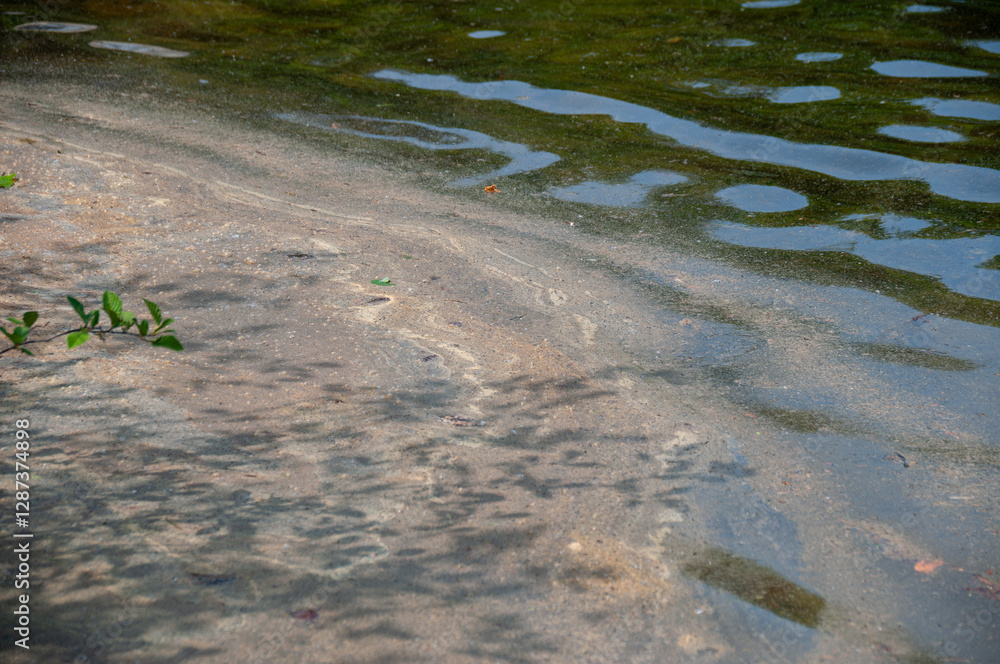
Photo 5

Photo 6
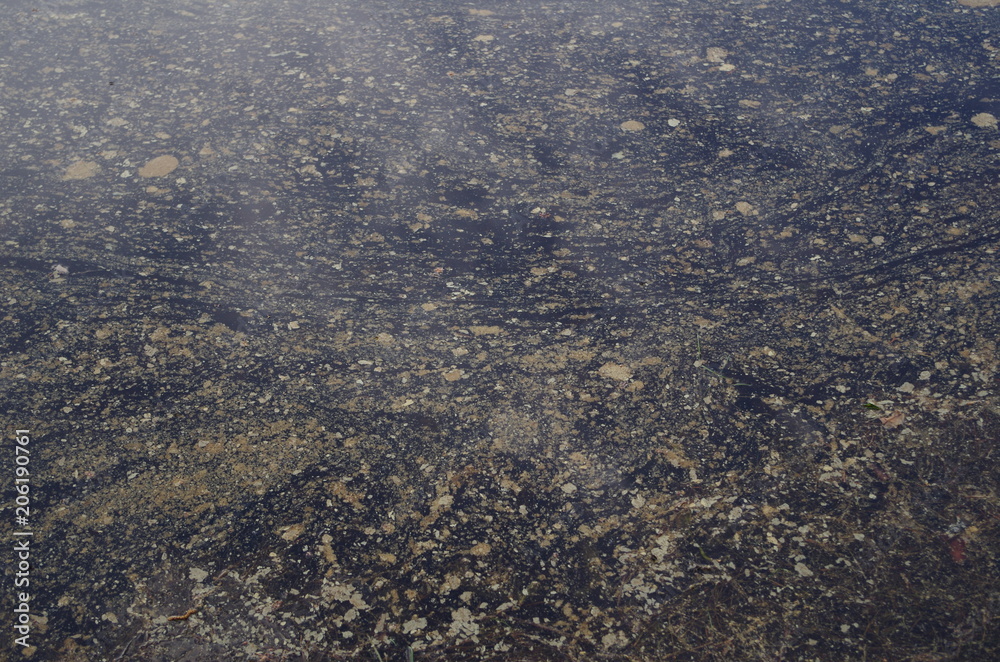
Keep Scrolling For Answers!
.
.
.
.
.
.
PHOTO ANSWERS: Photo 1: Bacteria-produced oil sheen. Photo 2: Pollen sheen. Photo 3: Petroleum-based oil sheen. Photo 4: Pollen sheen. Photo 5: Petroleum-based oil sheen. Photo 6: Mixture of bacteria-produced oil and pollen sheen. Note all photos were obtained from Adobe Stock Photos.
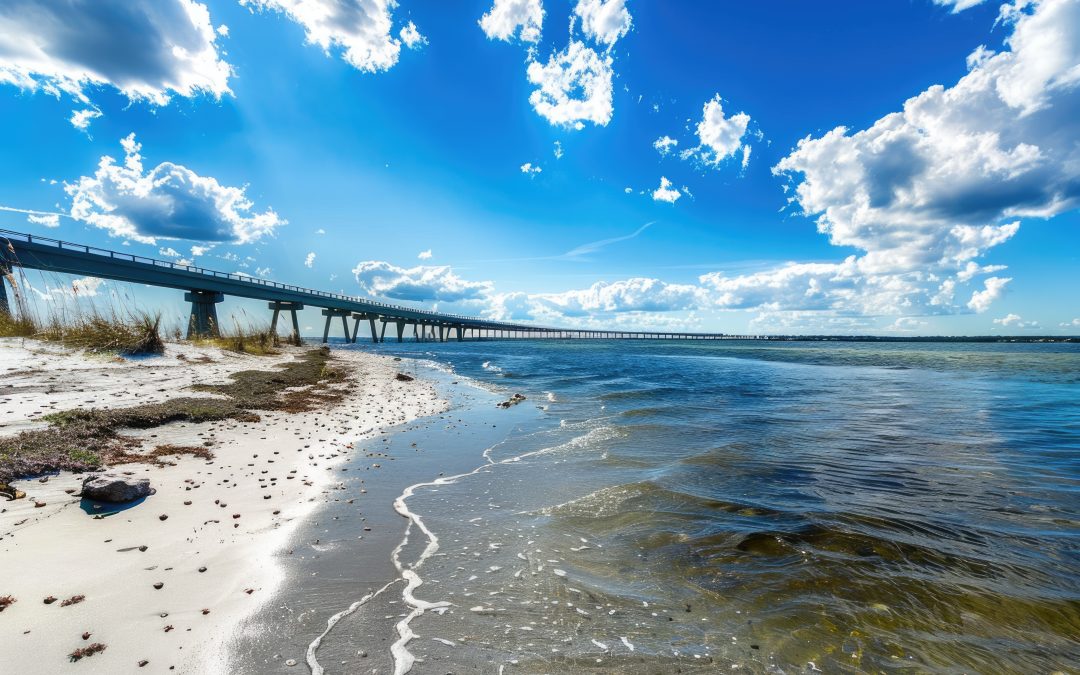
by Dana Stephens | Apr 11, 2025
Okaloosa Waterwatch is an opportunity to explore water quality data in selected locations spanning the Okaloosa County portion of the Choctawhatchee Bay.
A site is selected each month, and available water quality data are summarized and explained. The purpose is to understand water quality and the condition of our waters. Thanks to the Choctawhatchee Basin Alliance (CBA), water quality data has been collected frequently (monthly) for many years.
Below are the February and March Okaloosa Waterwatch water quality summaries. February highlights the mid-bay bridge (Niceville) location, and March highlights the entrance to Rocky Bayou (Niceville) location.
Check out the Okalooas Waterwatch YouTube channel for a personalized audio review of the water quality summaries. The YouTube channel is Okaloosa Waterwatch (@OkaloosaWaterwatch) or navigate directly using this link: https://www.youtube.com/channel/UCGPVMsyMiTU5BT9xyrFhuYQ
Please contact Dana Stephens, UF/IFAS Okaloosa County Sea Grant Extension Agent, for more information or to learn more about water quality in Okaloosa County. Email is dlbigham@ufl.edu and office phone is 850-689-5850.
Okaloosa Waterwatch February 2025 (PDF Link)
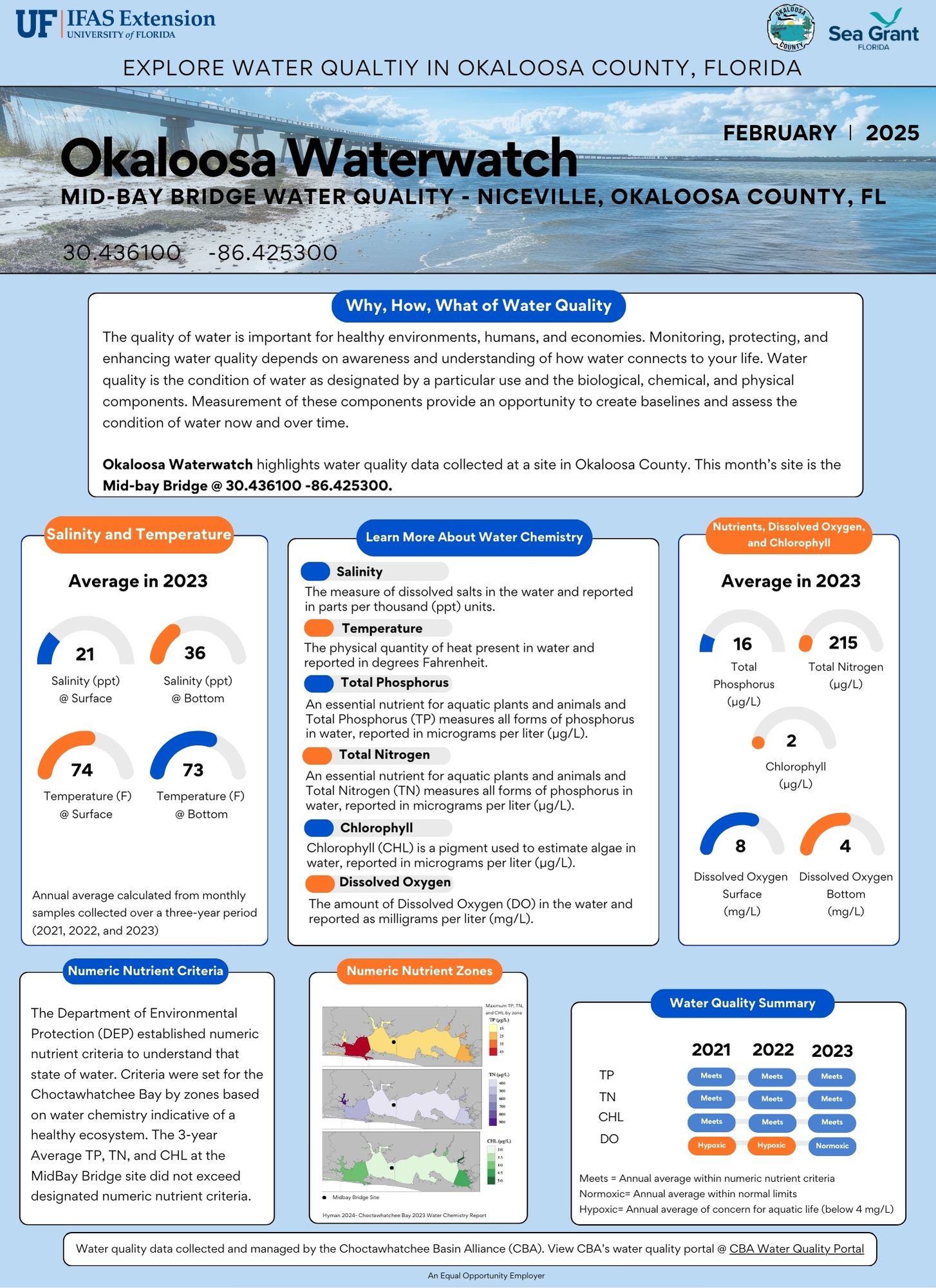
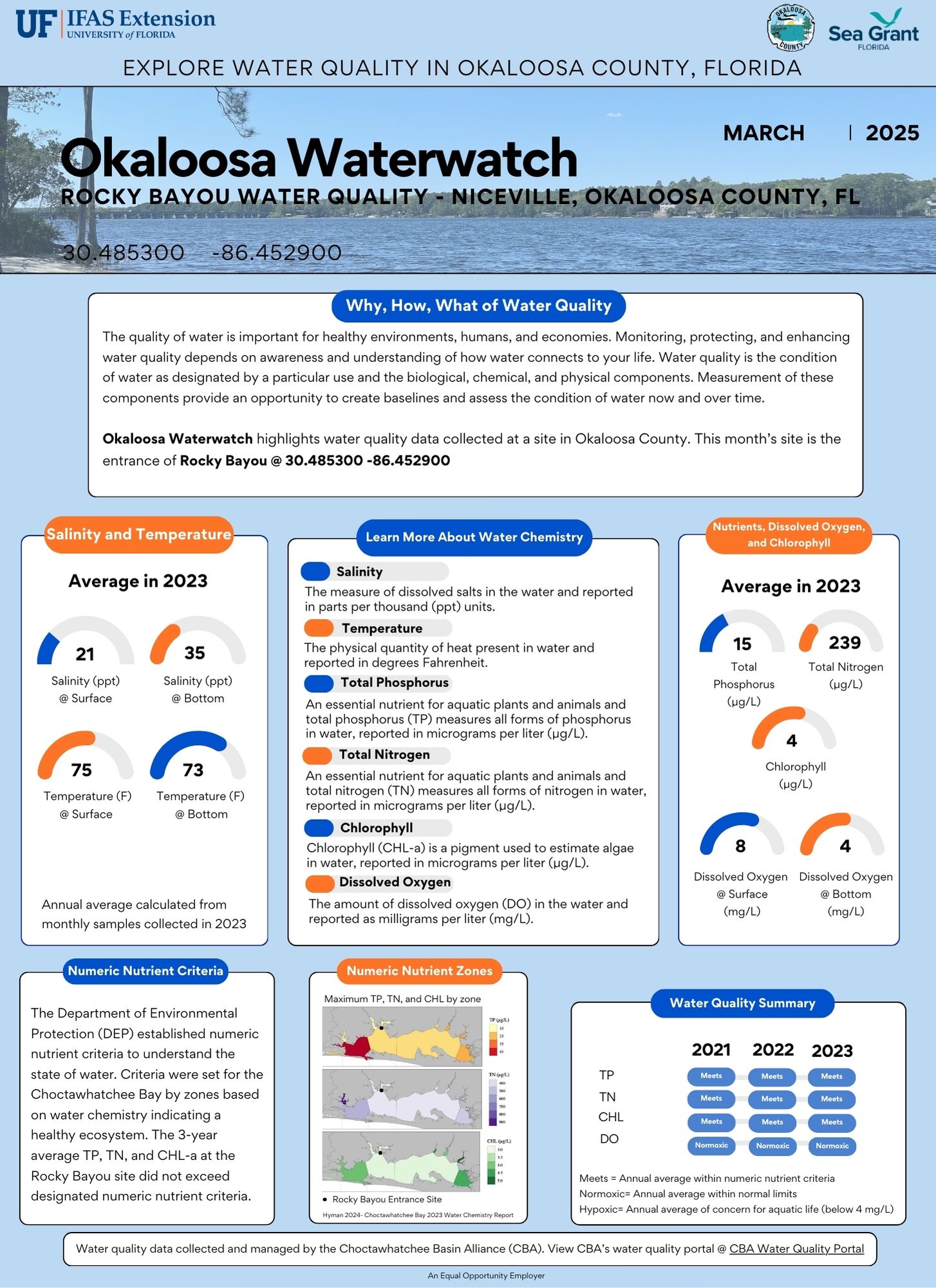
Okaloosa Waterwatch March 2025 (PDF Link)
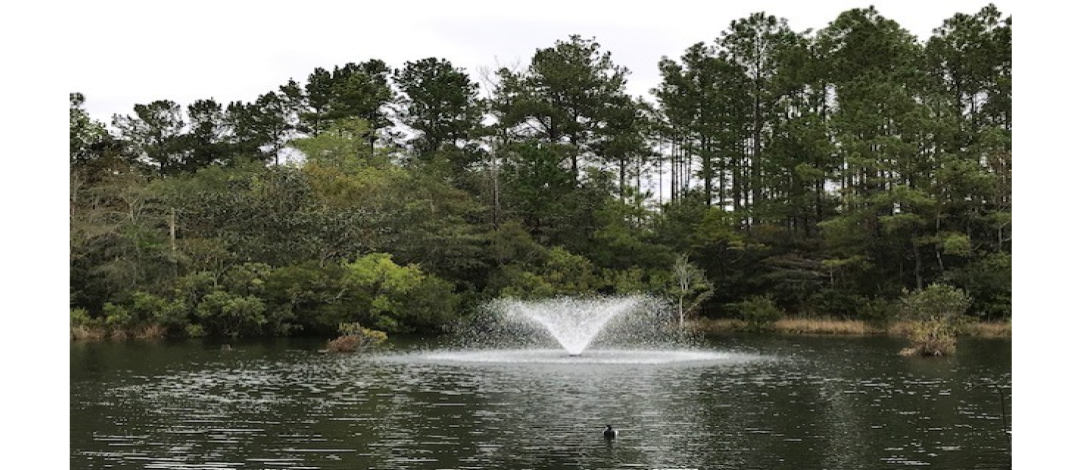
by Laura Tiu | Mar 7, 2025
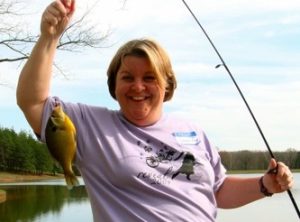 As spring approaches, I’ve been receiving more calls from local pond owners looking for advice on preparing their farm ponds for the season. Managing a pond in the Florida Panhandle can be tricky—especially when dealing with spring-fed ponds. While these ponds are often beautifully clear, their constant water turnover makes management a challenge.
As spring approaches, I’ve been receiving more calls from local pond owners looking for advice on preparing their farm ponds for the season. Managing a pond in the Florida Panhandle can be tricky—especially when dealing with spring-fed ponds. While these ponds are often beautifully clear, their constant water turnover makes management a challenge.
If you’re wondering how to get your pond ready for spring, here are some key considerations and resources to help guide you.
Start with a Water Quality Test
The first step in assessing your pond’s health is testing the water. I always recommend that pond owners bring a pint-sized water sample in a clean jar to their local Extension Office for analysis. Keep in mind that not all offices offer this service, and public testing options are limited. However, private labs and DIY testing kits are available—though they can be costly.
The most important parameters to check are pH, alkalinity, and hardness: pH should ideally range between 6 and 9 for a healthy fish population. Local ponds often hover around 6.5, making them slightly acidic.
Alkalinity and hardness measure the water’s ability to neutralize acids and buffer against sudden pH changes. For optimal pond health, alkalinity should be at least 20 mg/L, but many local ponds fall below this level.
Improving Pond Water Quality
If your pond’s water quality is less than ideal, there are two common ways to improve it: liming and fertilization.
Applying Agricultural Lime: Properly adding agricultural lime can raise alkalinity and stabilize pH levels. However, in high-flow ponds, lime tends to wash away quickly, making this method ineffective for ponds with constant discharge.
Fertilizing to Boost Productivity: Fertilization increases phytoplankton growth, which supports the pond’s entire food web, benefiting juvenile fish and invertebrates. Unfortunately, like lime, fertilizer is quickly washed out of high-flow ponds, making it ineffective in these cases.
Making the Best of Your Pond
If your pond has a continuous discharge due to spring flow, the best approach may be to embrace its natural clarity, even if it doesn’t support a thriving fish population. However, if your pond retains water without frequent outflow, you may be able to enhance its productivity with the right amendments.
For personalized guidance, contact your local UF/IFAS Extension Office. You can also start by reviewing this helpful fact sheet: Managing Florida Ponds for Fishing. By understanding your pond’s unique characteristics, you can make informed decisions to keep it healthy and enjoyable throughout the season.
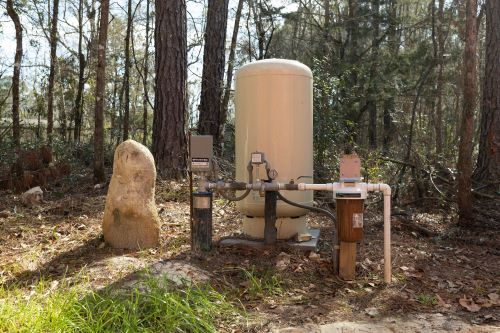
by Andrea Albertin | Oct 18, 2024
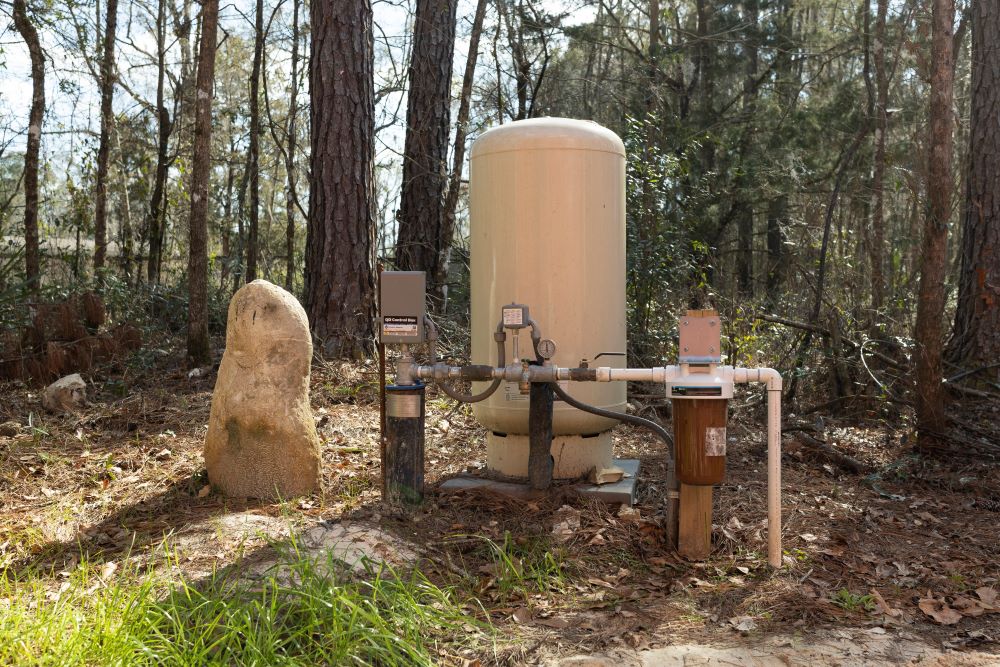
Private well system in Florida. Image: UF/IFAS, C. Wofford
UF/IFAS Extension and Mississippi State University are offering a workshop about the fundamentals of private well and onsite wastewater systems (septic systems) on October 24, 2024 from 6-8:30 pm CST. Join us virtually or in-person at the UF/IFAS Walton County Extension Office for an informative session that will cover everything you need to know about these essential systems. Whether you’re a homeowner, realtor, or simply interested in the topic, this event is perfect for gaining valuable insights. Don’t miss out on this chance to expand your knowledge!
Training Objectives:
- Provide descriptions of the basic components of private wells.
- Explain basic private well maintenance and provide recommendations for water testing and treatment if issues are found.
- Provide descriptions of the basic components of onsite wastewater treatment systems.
- Explain how and why the different components of an onsite wastewater system exist and function.
- Explain how poorly functioning onsite systems can reduce the asset life of onsite systems and negatively impact water quality.
- Describe the impact inadequate treatment and discharge can have on nearby private wells and groundwater.
- Discuss private well and septic system best practices after flooding.
Date and Time: 10-24-2024 @ 06:00 PM (CDT) to 10-24-2024 @ 08:30 PM (CDT)
In-Person Location: University of Florida/IFAS Walton County, Walton County Extension Office; 732 N 9th St, Defuniak Springs, FL 32433
Trainers: Dr. Jason Barrett, Associate Extension Professor and the Associate Director, Mississippi Water Resources Research Institute at Mississippi State University, Dr. Laura Tiu, Marine Science Extension Agent, Walton County and Dr. Andrea Albertin, Regional Water Resources Extension Agent, University of Florida
Who Should Attend:
- Residents with private wells and onsite wastewater systems can benefit from the concepts covered in this presentation.
- Owners or managers of septic tanks, on-lot wastewater systems, and private wells.
- Municipalities and county officials overseeing local septic programs and decentralized wastewater systems.
- Soil and Water Conservation Districts (SWCDs) professionals.
- Professionals in water quality and wastewater management, including engineers, planners, and environmental consultants.
- Anyone seeking resources or guidance related to private wells, decentralized wastewater systems, and septic tank management.
Please contact the Walton County Extension Office (850) 892-8172 if you have any questions about the event.

by Rick O'Connor | Oct 4, 2024
One of the top concerns with residents in our communities is water quality. Surveys I have conducted with the public support this statement. One of the top concerns with water quality in the coastal areas is health advisories. These are issued when concentrations of selected fecal bacteria are too high.
In coastal areas, the selected bacteria are Enterococcus. It is important to note that Enterococcus bacteria are found in the digestive systems of birds and mammals. So, its presence does not automatically mean there is human waste in the water. However, there are pathogens associated with bird and mammal waste humans should be concerned about. And very high concentrations are most likely due to human waste. Science is working on additional methods to confirm high levels of Enterococcus are human. It is assumed that these will one day be used.
Enterococcus bacteria are used in coastal waters due to their ability to tolerate higher salinity. Some species, such as E. coli, that are used in freshwater systems die in saline ones. This suggests that the waste is not there, when in fact it is. It is also important to know that Enterococcus bacteria in themselves are not health concern for us. They are in our digestive tracts. But their presence in the water indicates that waste is present and there are pathogens in this waste that are of concern – hence the advisories issued.
In this series we will look at three methods we can use to help reduce human waste from entering our local waterways. Those are (1) maintaining your septic system, (2) converting your septic system to sewer, and (3) maintaining your sewer lines. We will begin with maintaining your septic system.
Septic systems have been used in rural and suburban communities where sewer systems have not been available for decades. Even today, the growth of new neighborhoods is outpacing the sewer infrastructure to support them. Many of these new communities are using septic systems. If properly placed and maintained, septic systems can work well. But many are not placed in good locations, and most are not maintained.
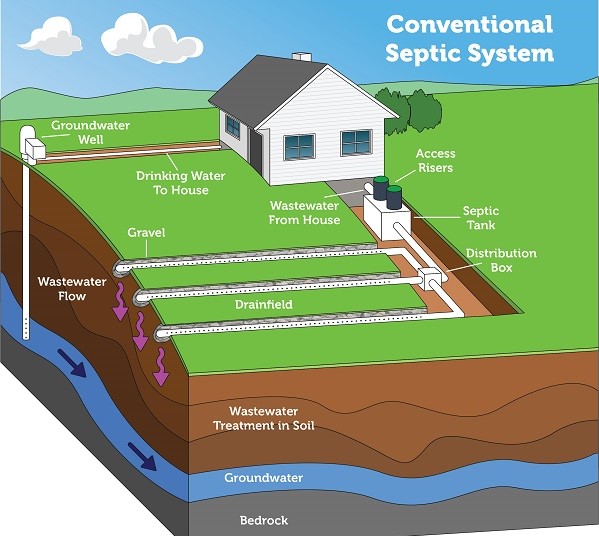
A conventional septic system is composed of a septic tank and a drainfield, where most of the wastewater treatment takes place. Image: US EPA
The system begins with the water leaving your home and entering a large tank made of concrete, fiberglass, or polyethylene buried in the yard. The average size of these tanks is 1000 gallons, but – depending on the number of bedrooms and bathrooms in the house, they could be larger. Here the sewage sits. Over time the solid waste will settle on the bottom (sludge) while the fats, oils, and grease float to the surface. The liquid layer in the middle (effluent) will flow from the tank into a series of smaller perforated drainpipes that slowly discharge into a drain field. A properly designed drain field will have a layer of sand that will allow draining of the effluent to occur.
Let’s talk about how to maintain this system.
- Do not overload the system with too much water. The tank is designed for a specific number of bedrooms/bathrooms. Overusing water can fill the tank and initiate leaking before the sewage has had time to settle. Watch your water use.
- Watch what you are flushing down the drain. Fats, oils, grease, and even milk will solidify and clog the lines. There are many products that describe themselves as “flushable”. They are, but they are not biodegradable. These two will cause clogs and backups in the system. Some harsh cleaning products can harm the bacteria within the tank who are breaking down the waste – these should be avoided. Also avoid using the garbage disposal. Septic systems were designed for water and sewage, not garbage and food. Compost your food waste instead.
- Periodically have your tank pumped and inspected. This is a step that many do not follow and can lead to leaking of untreated sewage into local waterways. It is recommended that you have your septic tank pumped and inspected once every 3-5 years. There are several businesses in your area who do this type of work. They can also provide advice on how to better maintain your specific system.
- Protect your drain field. Do not drive over this area of your lawn. Vehicles can compact the porous soil needed for efficient percolation and possible crack pipes. Planting trees and shrubs in this area can introduce roots into the lines, plant shallow root plants only. Design your landscape so that rainwater does not flow over the drain field during storms. The draining of your system is designed to be a slow process, allowing both physical and biological treatment of the waste to occur before reaching any water source. Rain and flooding conditions impede this from happening.
Developing a septic maintenance plan for your property can help reduce the number of health advisories your community will see. For more information contact your county health department or extension office.
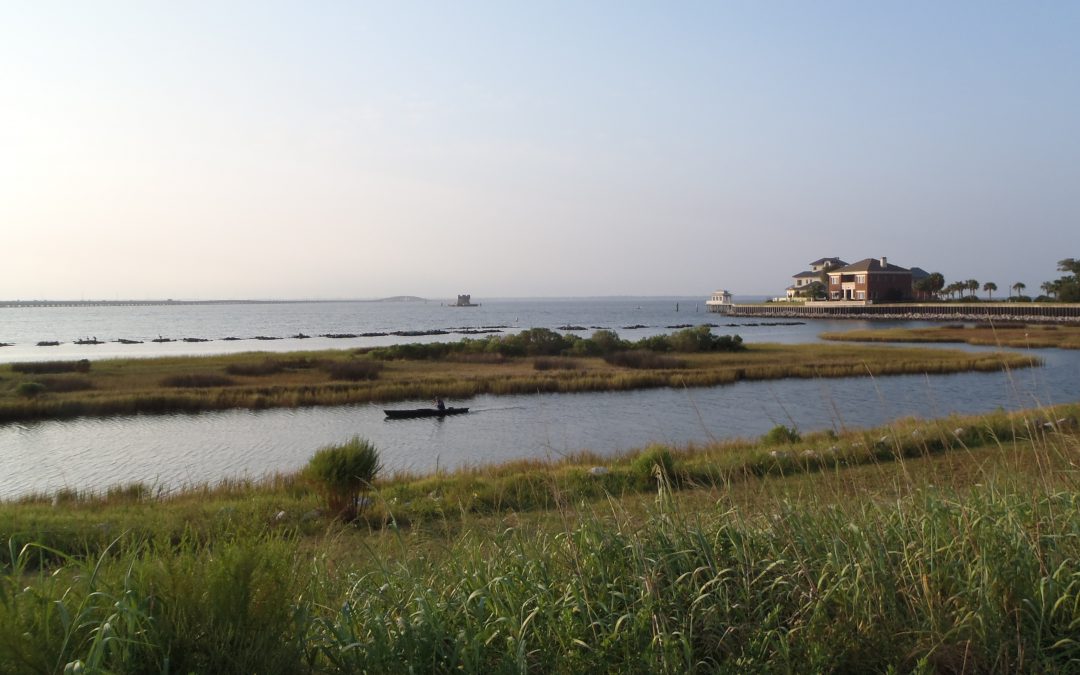
by Thomas Derbes II | Jun 21, 2024
In Part 1 of The Estuary’s Natural Filtration System article, we discussed the major contributors to natural filtration inside of the estuary. These examples included oysters, marsh plants, and seagrasses. In Part 2, we will discuss the smaller filter-feeding organisms including tunicates, barnacles, clams, and anemones.
Tunicates
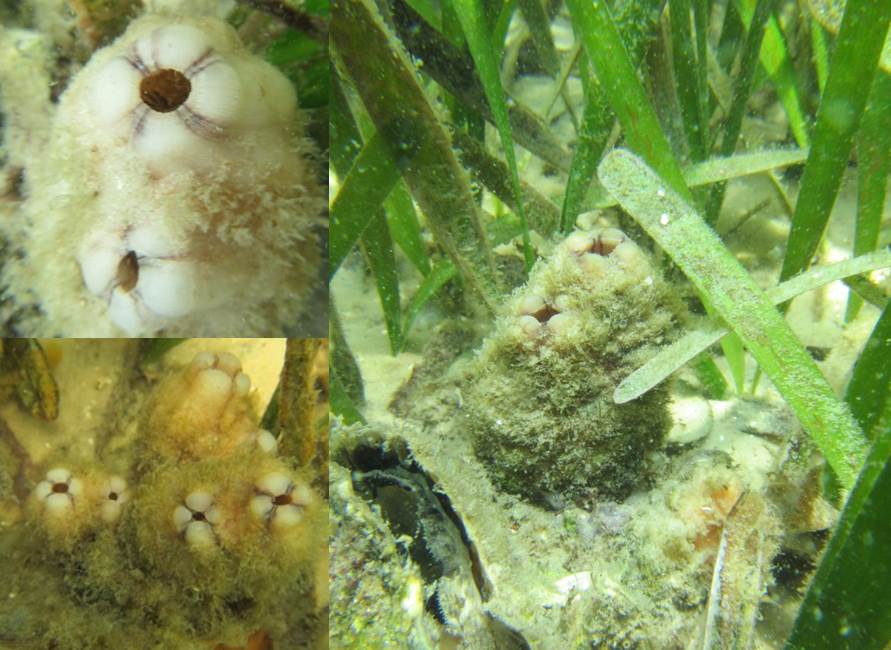
Pleated Sea Squirt – Photo Credit: Don Levitan, PH.D. FSU
Tunicates, also known as sea squirts, are very interesting marine invertebrates and can be easily confused for a sponge. There are many different types of tunicates in the estuaries and can be either solitary or colonial. You might’ve seen these at an aquarium attached to different substrates, and when removed from the water, their name sea squirt comes into play. Tunicates have a defense mechanism to shoot out the water inside their body in hopes of being released by any predator.
Tunicates are filter feeders and intake water through their inhalant siphons and expel waste and filtered water through their exhalant siphons. Tunicates can filter out phytoplankton, algae, detritus, and other suspended nutrients. The tunicate produces a mucus that catches these nutrients as it passes through, and the mucus is then conveyed to the intestine where it is digested and absorbed.
An invader to the Gulf of Mexico, the Pleated Sea Squirt (Styela plicata), hitched rides on the hulls of ships and found the Gulf of Mexico waters very favorable. You can sometimes spot these organisms on ropes that have been submerged for a long period of time in salty waters. Even though they are non-native, these sea squirts can filter, on average, 19 gallons of water per day.
Barnacles
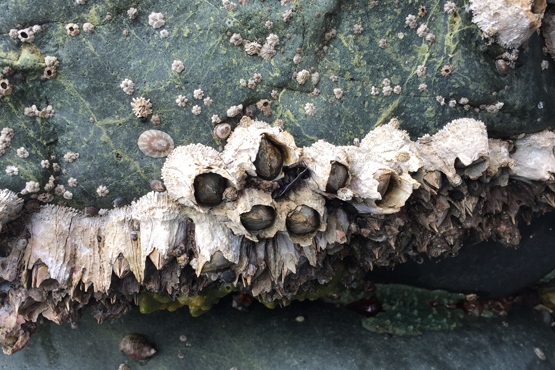
Barnacles along the seashore is a common site for many.
Photo: NOAA
One organism that seems ubiquitous worldwide is the barnacle (Genus Semibalanus and Genus Lepas). The Genus Semibalanus contains the common encrusting barnacle we are accustomed to seeing in our waterways along pilings, submerged rocks, and even other animals (turtles, whales, crabs, and oysters). The Genus Lepas contains Gooseneck Barnacles and can be seen attached to flotsam, floating organic debris, and other hard surfaces and have a stalk that attaches them to their substrate. Interesting fact, certain gooseneck barnacle species are eaten in different parts of the world.
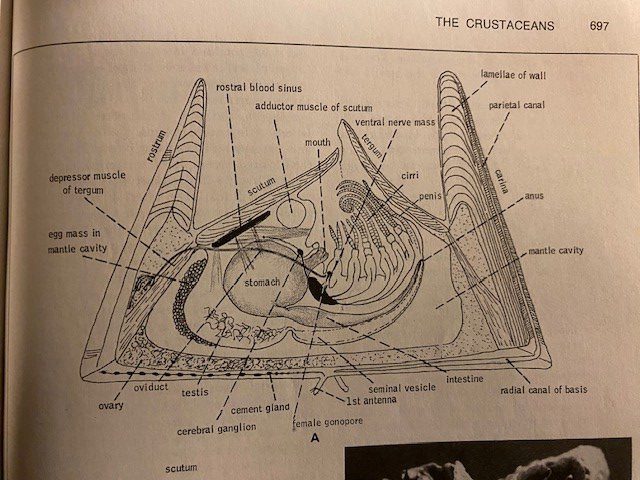
This image from a textbook shows the internal structure of a barnacle. Notice the shrimplike animal on its back with extendable appendages (cirri) for feeding.
Image: Robert Barnes Invertebrate Zoology.
Barnacles have over 2,100 species, are closely related to crabs and lobsters, and are a part of the subphylum Crustacea. At first glance, you might not think a barnacle is closely related to crabs, but when you remove the hard plates surrounding it, the body looks very similar to a crab. Barnacles also have life cycle stages that are similar to crabs; the nauplius and cyprid developmental stages. Inside of the hard plates is an organism with large feather-like appendages called cirri. When covered by water, the barnacles will extend their cirri into the water and trap microscopic particles like detritus, algae, and zooplankton. Barnacles are at the mercy of tides and currents, which makes quantifying their filtering ability difficult.
Hard Clams
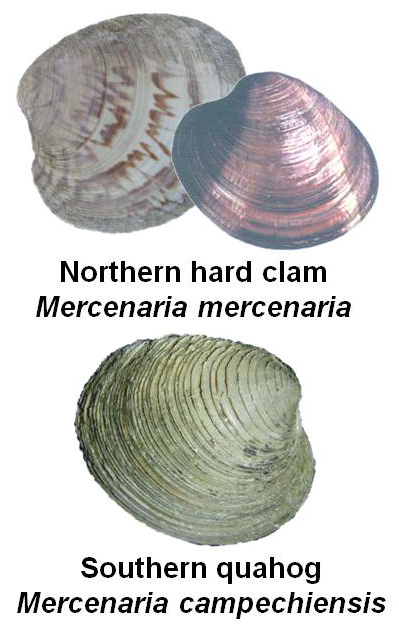
Clams of North Florida – UF/IFAS Shellfish
Even though not as abundant in the Florida Panhandle as they were in the 1970’s – 1980’s, hard clams (Mercenaria mercenaria and M. campechiensis) can still be found in the sand along the shoreline and near seagrass beds. These clams are also known as Quahogs and are in the family Veneridae, commonly known as the Venus clam family, and contain over 500 living species. Most of the clams in the family Veneridae are edible and Quahogs are the types of clams you would see in a clam chowder or clam bake.
Being the only bivalve on this list does not make it any less important than the oyster or scallop on Part 1’s list. In fact, a full-grown adult Southern Quahog clam can filter upwards of 20 gallons of water per day and have a lifespan of up to 30 years. Clams also live a much different lifestyle than their oyster and scallop cousins. Clams spend the majority of their life under the sand. Their movement under the sand helps aerate and mix the soil, which can sometimes stimulate seagrass growth.
Right outside the Florida Panhandle and in the Big Bend area, Quahog clams are commercially farmed in Cedar Key. Southern Quahog clams are also being used for restoration work in South Florida. Clams are being bred in a hatchery and their “seed” are being released into Sarasota Bay to help tackle the Red Tide (Karenia brevis) issue. According to the project’s website, they have added over 2 million clams since 2016, and the clams are filtering over 20 million gallons of seawater daily.
Anemones
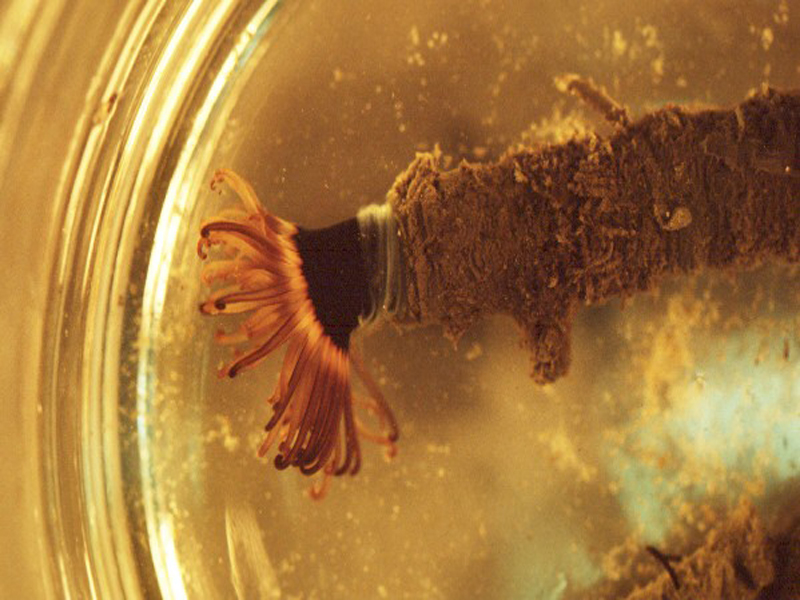
Tube-Dwelling Anemone Under Dissection Scope – UF/IFAS Shellfish
Anemones are beautiful Cnidarians resembling an upside-down, attached jellyfish, which couldn’t be closer to the truth. The phylum Cnidaria contains over 11,000 species of aquatic animals including corals, hydroids, sea anemones, and, you guessed it, jellyfish. Anemones come in many different shapes and sizes, but the common estuary anemones include the tube-dwelling anemone (Ceriantheopsis americana) and the tricolor anemone (Calliactis tricolor), also known as the hitchhiking anemone. If you have ever owned a saltwater aquarium, you might have run into the pest anemone Aiptasia (Aiptasia sp.).
Anemones filter feed with their tentacles by catching plankton, detritus, and other nutrients as the tide and current flows. The tentacles of the anemone are lined with cnidocytes that contain small amounts of poison that will stun or paralyze the prey. The cnidae are triggered to release when an organism touches the tentacles. If the anemone is successful in immobilizing the prey, the anemone will guide the prey to their mouth with the tentacles. Just like the barnacle, anemones are at the mercy of the tides and currents, and filtration rates are hard to calculate. However, if you ever see an anemone with food around, they move those tentacles to and from their mouths quickly and constantly!
In Parting
As you can see, there are many different natural filters in our estuary. Healthy, efficiently filtering estuaries are very important for the local community and the quality of the waters we love and enjoy. For more information on our watersheds and estuaries and how to protect them, visit Sea Grant’s Guide To Estuary-Friendly Living.





















